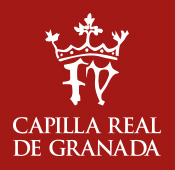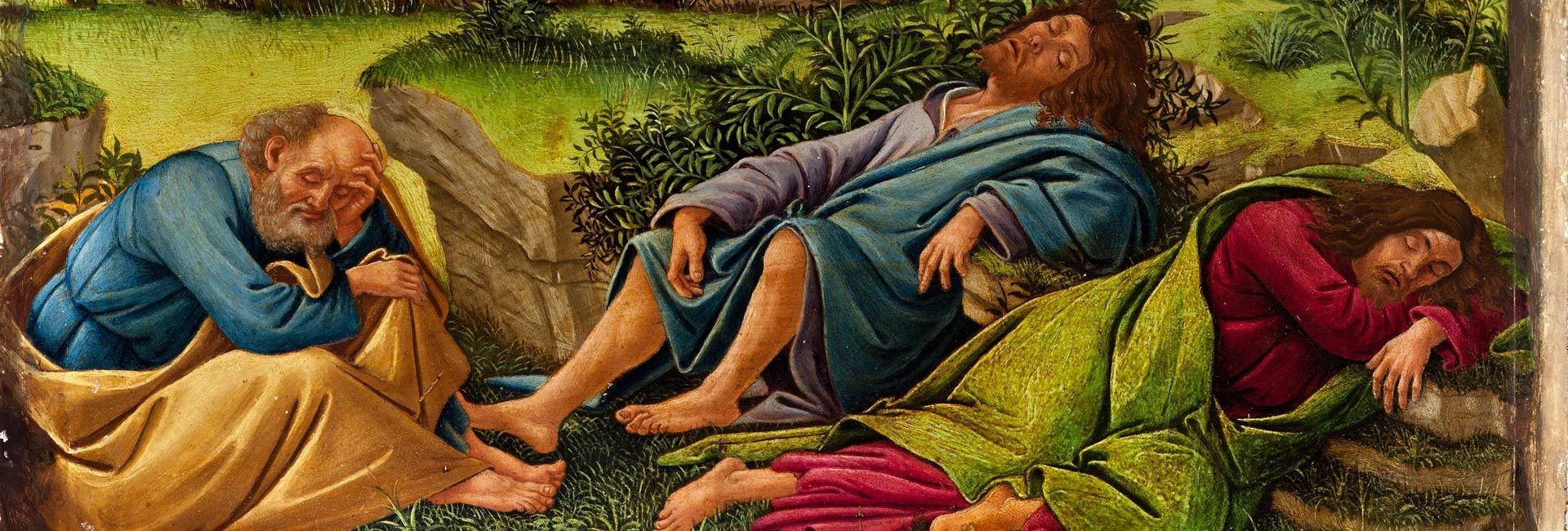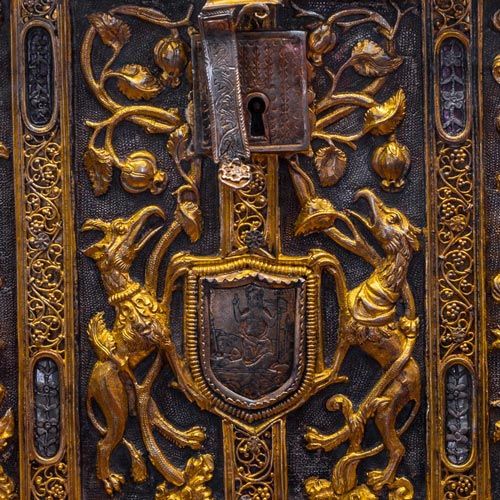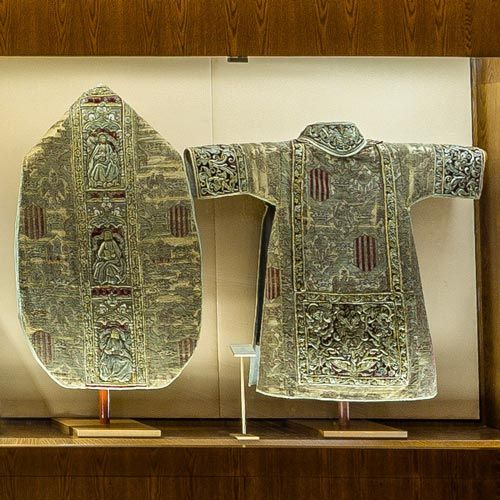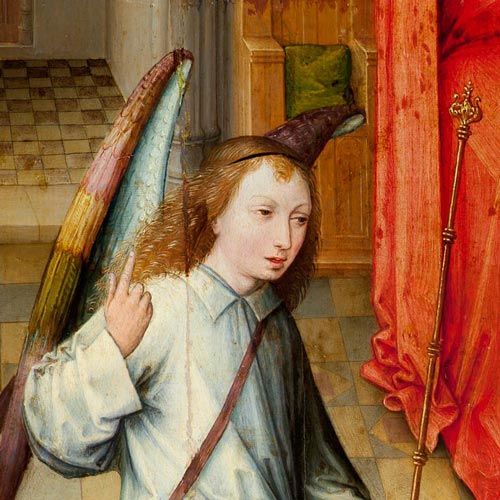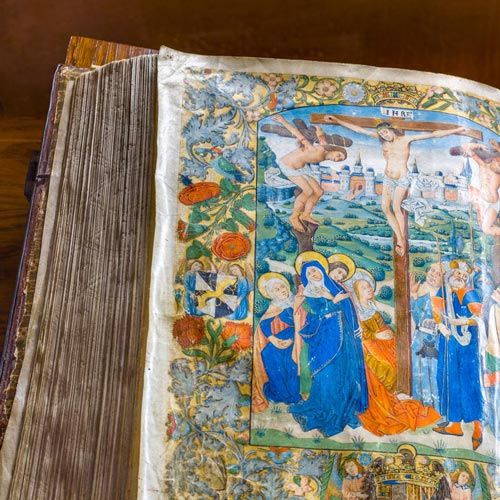The Royal Chapel has an important collection of works that come from the palettes of Italian and Spanish painters from the XV century to the XVIII century. The paintings from the XV and XVI centuries created by Italian and Spanish painters with a solid education in Italy are especially interesting. The wealth of Baroque paintings is less important but there are still some masterpieces.
PAINTINGS FROM THE XV CENTURY
Two masters, Sandro Botticelli (1445-1510) and Pietro Perugino (c. 1450-1523) have bequeathed two spectacular paintings to us.
The refined, harmonious, sometimes idyllic and always unquestionably poetic painting that personifies Botticelli distinguishes the Agony in the Garden panel. A skillful hierarchical order in the composition, supported by the layout of the landscape, allows the artist to place the characters in the story as desired. The constant virtuosity of the drawing, the quality and texture of the chromatic range or the total harmony which is the soul of the simple, luminous countryside, are identified with the artistic style of the painter from Lorenzo de Medici.
A panel of outstanding pictorial beauty and strong emotion known as Christ, the Man of Sorrows, can only be attributed to a master of unquestionable stature and well defined artistic personality such as Perugino or one of his circle. Christ’s naked chest, designed with fluidity and accuracy emphasizes his prominence enhanced by the cool shades of the green background and by the wisdom of the effects that emanate from lighting. The realism of Christ’s figure reflects a dreaming mysticism full of lyricism, inseparable from many other creations by the painter from Umbría. The unlimited loneliness and the impassive silence are completed with the image of his exhausted body near collapse.
SPANISH MASTERS FROM THE AGE OF THE CATHOLIC KING AND QUEEN
Bartolomé Bermejo (c. 1430-1496/98) and Pedro Berruguete (c. 1450-1504) lived during the reign of the Catholic King and Queen; they were two painters who created their works within the last third of the XV century, with very different artistic personalities.
Two paintings by Bermejo are exhibited, placed on the front and back of the same panel: the Epiphany and the Holy Face.
In the first painting, the painter, with solidity of design and a mastery of technique with oils, enjoys an analysis of reality: characters and objects evoke his fascination with reality. The richness of colour and the effects of the lighting underline some of the best qualities of the panel.
In the second painting, he evokes an intense parallelism with one of his masterpieces: The Pietà of Canon Luis Desplá (Cathedral of Barcelona), 1490.
Among the most select of the panels in the collection there is an interesting version of St. John the Evangelist on Pathmos from Pedro Berruguete who is from Palencia (a region in the northwest of Spain), and who is one of the most qualified precursors of the new pictorial style which would light the Renaissance.
This Royal Chapel panel is a painting from after his stay in Urbino, where he became acquainted with the new aesthetic and technical approaches of the Italian painters of the XV century. Together with his constant fascination for everything Flemish, he mixes resources that come from the Italians.
Among the abundance of gold and the fragility of the landscape, the elegance, strength and veracity of the Apostle in his red robe bending over the writing of his gospel, flanked by his traditional symbol of the eagle, stand out.
RENAISSANCE PAINTINGS
In the field of painting, Pedro Machuca (d. 1550) and Jacobo Florentino “The Indaco” (1476-1526) give evidence of their excellent work with a group of panels for the Plateresque altarpiece that up to 1735 was situated in the Chapel of the Holy Cross. Most experts agree on attributing to Machuca: The Agony in the Garden, The Prendimiento, the Descent into Limbo and the Ascension (now lost), and to Florentino they attribute: Emaus, the Last Supper and Pentecostés. The paintings of the Descent into Limbo and of Emaus are exhibited in the transept of the Chapel.
The story of the Prendimiento is set at night, softened by veiled suggestions of soft moonlight which are violently interrupted –in the foreground- by the vibrating, powerful light of the torch which is flourished by a henchman, and by the brazier placed in the upper left part of the composition. The analysis and effects of that light on the characters, spaces and objects, with its richness in shades, traps the eye of the viewer.
The skill of the pictorial approaches in this panel show a mature artist with a variety of technical resources.
In the Meeting of Christ with the disciples of Emaus the painter joins naturalistic will and his fascination for artistic values. The firmness of the drawing and a rich chromatic choice give life to three vigorous figures with aristocratic manners.
A spacious countryside, resolved with solid natural elements and the vibration of twilight confirm altogether the monumental aims of the representation.
In this panel, as some specialists affirm, Jacobo Florentino leans toward the work of Michelangelo.
BAROQUE PAINTING
The canvases of this epoch are almost all works of the School of Granada. There are many creations from this School, from anonymous and not very well-known masters. Experts and interested visitors find a reason to approach the canvases of not well-known painters or of those with few works. Works by Francisco Alonso Argüello, Esteban de Rueda, Melchor de Guevara or Jerónimo Cárcel, among others, are representative of this outstanding legacy. We will comment on two works of this legacy, one by Alonso Cano (1601-1667) and another one by José de Cieza (1652-1692).
The pictorial personality of Alonso Cano, shown in his great canvases for the adjacent cathedral temple, is also capable of creating more intimate works. The Virgin with Child shows his art in approaching what is small and delicate. Technical wisdom, sensitivity and lyricism are combined in this canvas of outstanding beauty, where Cano transmits beloved peace, sweetness and intimacy.
The correctness of the design, the chromatic richness, the harmony in the inclination of the light, which highlights volumes, qualities and textures, corroborate the sublime poetry of the work.
One of Cieza’s most interesting creations from his Granada period is St. John the Baptist: his emphasis on accentuating the resources of expression and gesture of the late Baroque cannot hide a marked lyricism. The modulation of light is essential for the spacial definition and for the suggestive blendings on the figure of John the Baptist. Granada affected the painter in such a way that he is involved in the veneration of the Flemish which is related to the School of Granada; the red robe of St. John is suggestive of this line.
